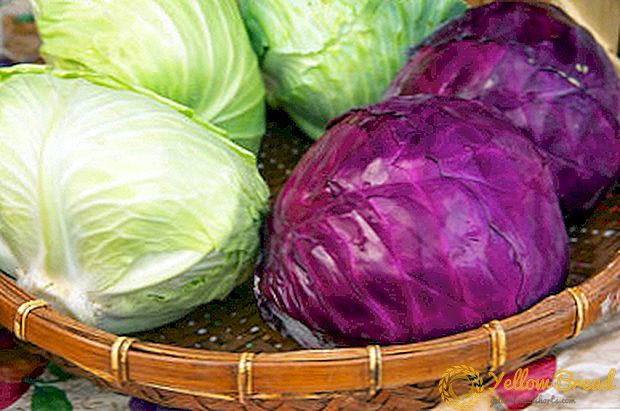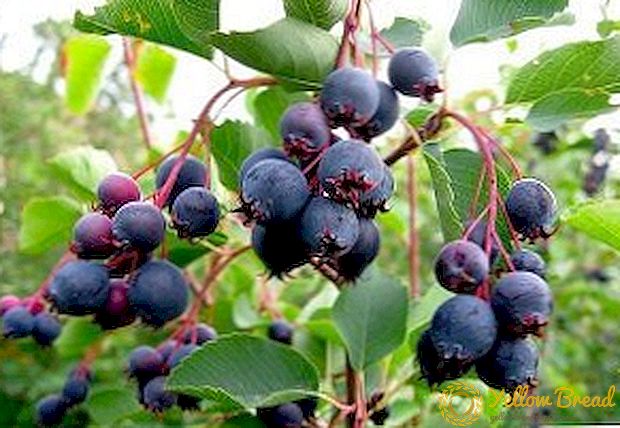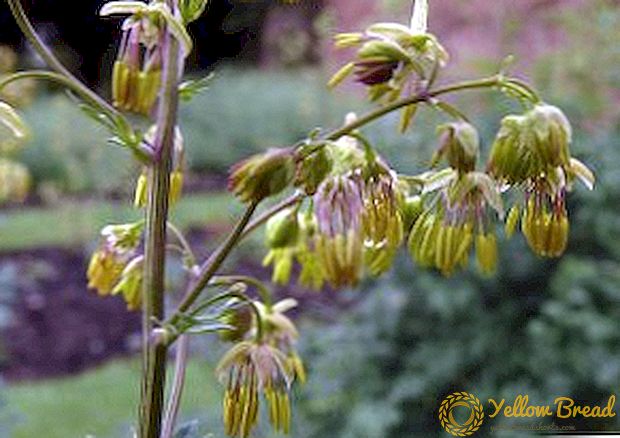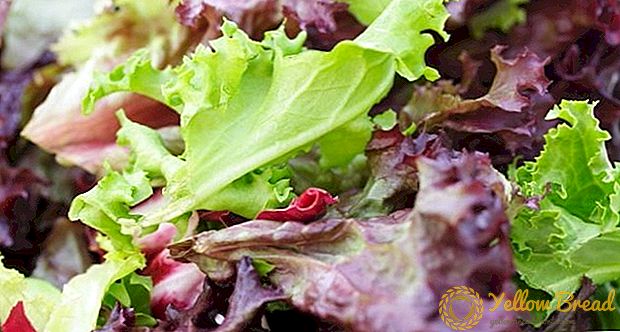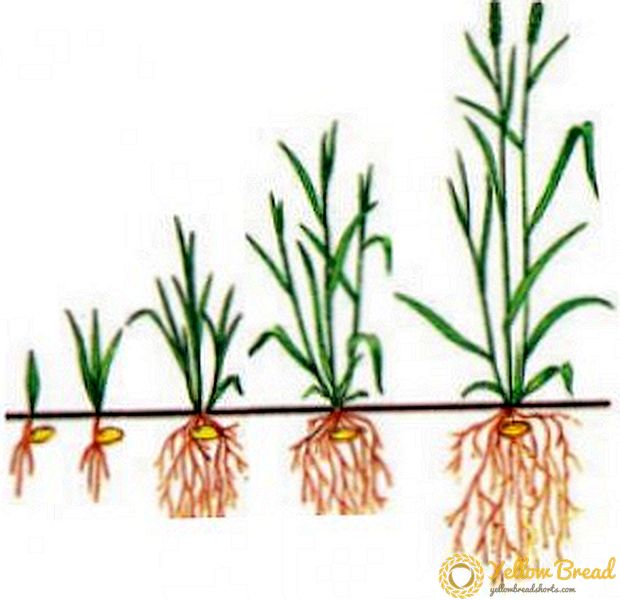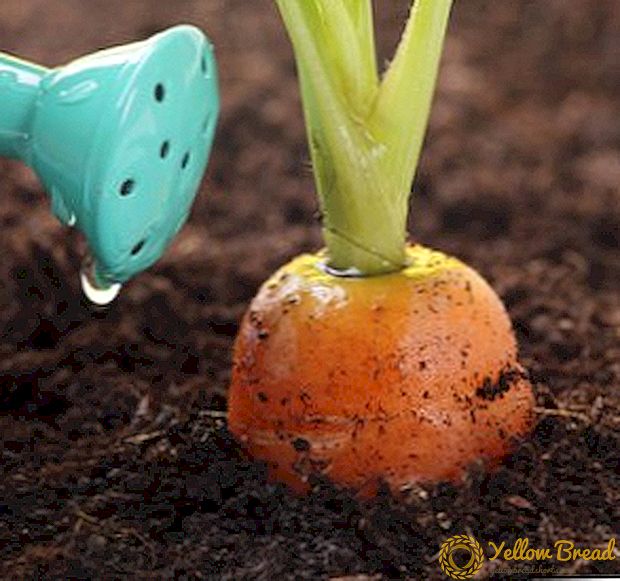 Growing carrots is not difficult compared to other vegetable crops, but this process should be considered as carefully.
Growing carrots is not difficult compared to other vegetable crops, but this process should be considered as carefully.
The main secret is to provide the vegetable with regular weeding and loosening, as well as the proper watering of the carrots - this will be the key to a good harvest.
- When and how to water a vegetable
- Irrigation rates
- Before sowing
- After sowing
- Shoots carrots
- In the phase of formation of root crops
- Adult plants
- How to combine irrigation with dressing
- Peculiarities of irrigation on mulch soil
When and how to water a vegetable
Until plants have a strong root system, they require a lot of moisture and do not tolerate its lack. But at the same time for carrots stagnant water stagnation in the soil is destructive - waterlogging leads to rotting of young sprouts, and they can die. Therefore, it is better to water the beds more often, but in small portions, checking how deep the moisture has penetrated. So, it is quite possible to moisten the plants every 4-5 days, watering from a watering can. The main thing is to prevent overmoistening of the soil. Also, water carrots need after each thinning. Removing excess sprouts traumatizes the root system of the remaining plants, therefore, in order to get well established in the ground again, they need additional moisture.
The main problem with the water supply of many gardens is that the water pumped from the well or the water from the well is too cold.
 Therefore, water from a well or column before irrigation should be accumulated in a tank - a barrel or an old bath, until it has an ambient temperature, and from there take it with a watering can or pump it with a pump.
Therefore, water from a well or column before irrigation should be accumulated in a tank - a barrel or an old bath, until it has an ambient temperature, and from there take it with a watering can or pump it with a pump.Irrigation rates
How to water carrots to get a rich harvest, consider below:
- The maximum sensitivity to humidity conditions is the postseeding period before the formation of root crops.
- The optimal level of natural precipitation (provided a uniform distribution during the growing season) to achieve good results - 400-500 mm.
- Culture water consumption is 4000-4500 m3 / ha (sprinkling up to 5500 m3 / ha), the highest water consumption occurs in July and August.
- To obtain high yields, 68-74 m3 / ha are spent per ton of products.
- Changes in humidity lead to cracking of root crops as a result of growth spikes after a period of rest.

Daily moisture consumption for growing periods:
- Sowing, seedlings and the beginning of the formation of root crops - 23-32 m3 / ha.
- Intensive formation of root crops to the state of technical ripeness - 35-43 m3 / ha.
- The final stage of the growing season -22-27 m3 / ha.
Before sowing
When sowing carrots, it is very important that the soil is not dry, otherwise the seeds will germinate for a long time and will not grow evenly, but in very dry soil they will not sprout at all. If the soil is dry, then a few days before planting the seeds it is necessary to moisten it abundantly, pouring from a watering can or hose with a special rain nozzle.

After sowing
To stimulate the emergence of seedlings with a lack of natural moisture (especially important for the summer-autumn period), one irrigation of 300-400 m3 / ha is carried out on sprinkling, several irrigation of 20-30 m3 / ha on drip irrigation.
The recommended time of day for watering is evening hours. Carrots that are stored, stop watering for 2-3 weeks before harvest. 
Shoots carrots
It is best to water the carrots according to the following scheme:
- It is necessary to water carrots most abundantly and often in the period of emergence of shoots. This should be done until 3-4 stems are formed.
- When the root has already begun to ripen and a little poured, you can water a little less.Watering should be regular, adjust the amount of water depending on the condition of the soil. On heavy soil water will need more.
- More attentively to watering should be treated approximately from the middle of August. This is the period when the root due to the irregularity of watering can form a crack.
In the phase of formation of root crops
Watering carrots should be carried out regularly, how often to do this, you should ask the experts before planting a vegetable in advance. If before the plant begins to form a root crop, watering was quite frequent, but small in volume, then over time, the frequency of soil moistening should be reduced, and the amount of water used, on the contrary, increased. As the carrot grows, it should be watered on average every 7-10 days, and the amount of moisture should be increased to 15-20 liters per square meter of land.
Moisture should penetrate 10-15 cm deep into the soil, but not stagnate.
It must be remembered that with a lack of moisture, the roots will be small, hard and tasteless, and if it is abundant, lateral processes will form on them and the central root may die.It is also worth considering that in hot sunny days you need to water the vegetable early in the morning or in the evening.
If you do it in the midst of the sun, then the moisture quickly evaporate from the soil, vegetables can overheat and even get sunburn. After each watering, it is necessary to slightly loosen the soil between the rows to prevent the formation of a hard crust and to increase the air permeability of the earth. 
Adult plants
In the period when the roots are almost fully formed, watering should be reduced to a minimum, respectively, increasing the amount of water used. At this time, an excess of moisture will negatively affect the quality and taste of the fruit: they can form a kind of hair and many lateral roots.
But it is also impossible to allow the soil to dry out, otherwise the roots can crack and become stiff.
It will be useful for novice gardeners to find out if they already sprinkle ripe carrots, but at once we emphasize that you need to moisten the beds regularly, keeping to a certain schedule. Carrots are quite sensitive to the ingress of moisture.  Approximately 3 weeks before harvesting, watering the beds should be completely stopped and only slightly moisten the soil before digging the roots. So it will be much easier to extract carrots, and the fruits themselves will be stored longer.
Approximately 3 weeks before harvesting, watering the beds should be completely stopped and only slightly moisten the soil before digging the roots. So it will be much easier to extract carrots, and the fruits themselves will be stored longer.
How to combine irrigation with dressing
If you have well fertilized the soil for planting carrots since autumn, then it is possible to grow a good crop of root crops and without additional dressings. But it is still better to make 2-3 additional feeding during the whole growing season.
 And best of all, in the second half of the growing season, when watering carrots, add an infusion of ash into the water (1 liter of infusion per 10 liters of water), since ash is the best potash fertilizer that is remarkably absorbed by all plants.
And best of all, in the second half of the growing season, when watering carrots, add an infusion of ash into the water (1 liter of infusion per 10 liters of water), since ash is the best potash fertilizer that is remarkably absorbed by all plants.In addition, ash protects plants from many diseases and pests. You can even just once a week before watering sprinkle carrot beds with wood ash.
It is very good to carry out foliar feeding of carrots with a solution of boric acid (1 teaspoon per 10 liters of water). Such feeding will be enough to hold two times: during the period of active growth of the underground part of the vegetable (first half of July) and,when the carrot begins to ripen (first half of August).
Peculiarities of irrigation on mulch soil
This technique partially replaces irrigation and loosening, as the soil shelter contributes to the preservation of humidity, improvement of temperature, destruction of weeds, reproduction of microorganisms and increased fertility. When mulching does not form a soil crust and therefore there is no need for loosening.  Until mid-summer, the mulch soil retains two times more productive moisture than in the soil without mulch. Since the mulched soil is more loose, it is more moisture-consuming and retains more moisture after rain and watering. When mulching, the soil does not overheat on hot days, but retains heat on cold days and nights.
Until mid-summer, the mulch soil retains two times more productive moisture than in the soil without mulch. Since the mulched soil is more loose, it is more moisture-consuming and retains more moisture after rain and watering. When mulching, the soil does not overheat on hot days, but retains heat on cold days and nights.
It is necessary to water rather rarely and plentifully, than often and gradually. There is a technique of watering the garden, designed for a long absence of gardeners.So that the earth does not dry out in a few days, apply furrow irrigation.
In this case, the furrows should have a small slope, and after abundant watering they should be covered, for example, with weeded weed. If you are going to water the soil after a good drying and before the rain, then it is advisable to break through it so that the water is better absorbed.


